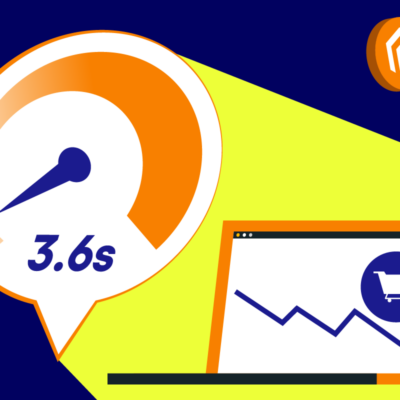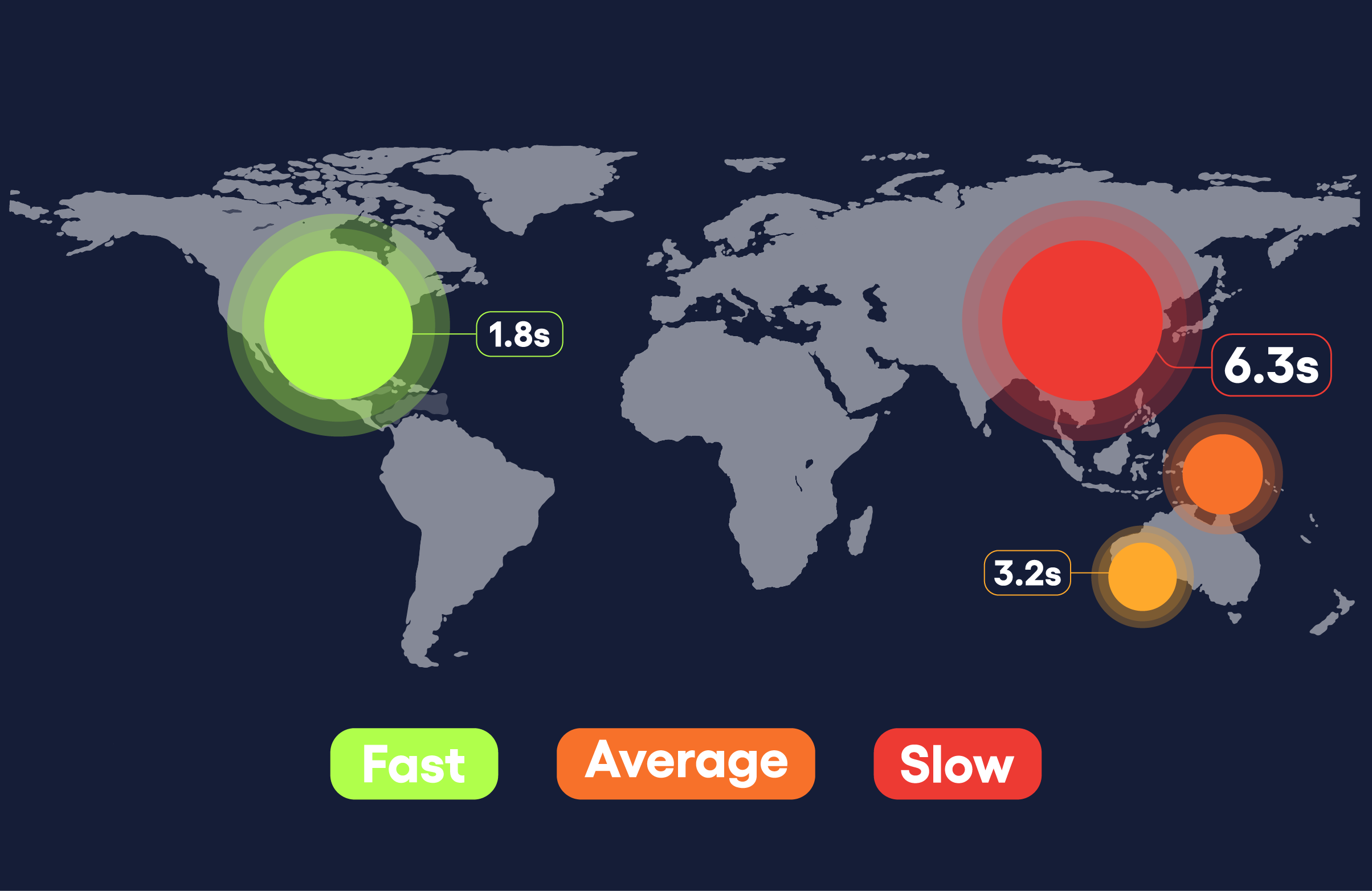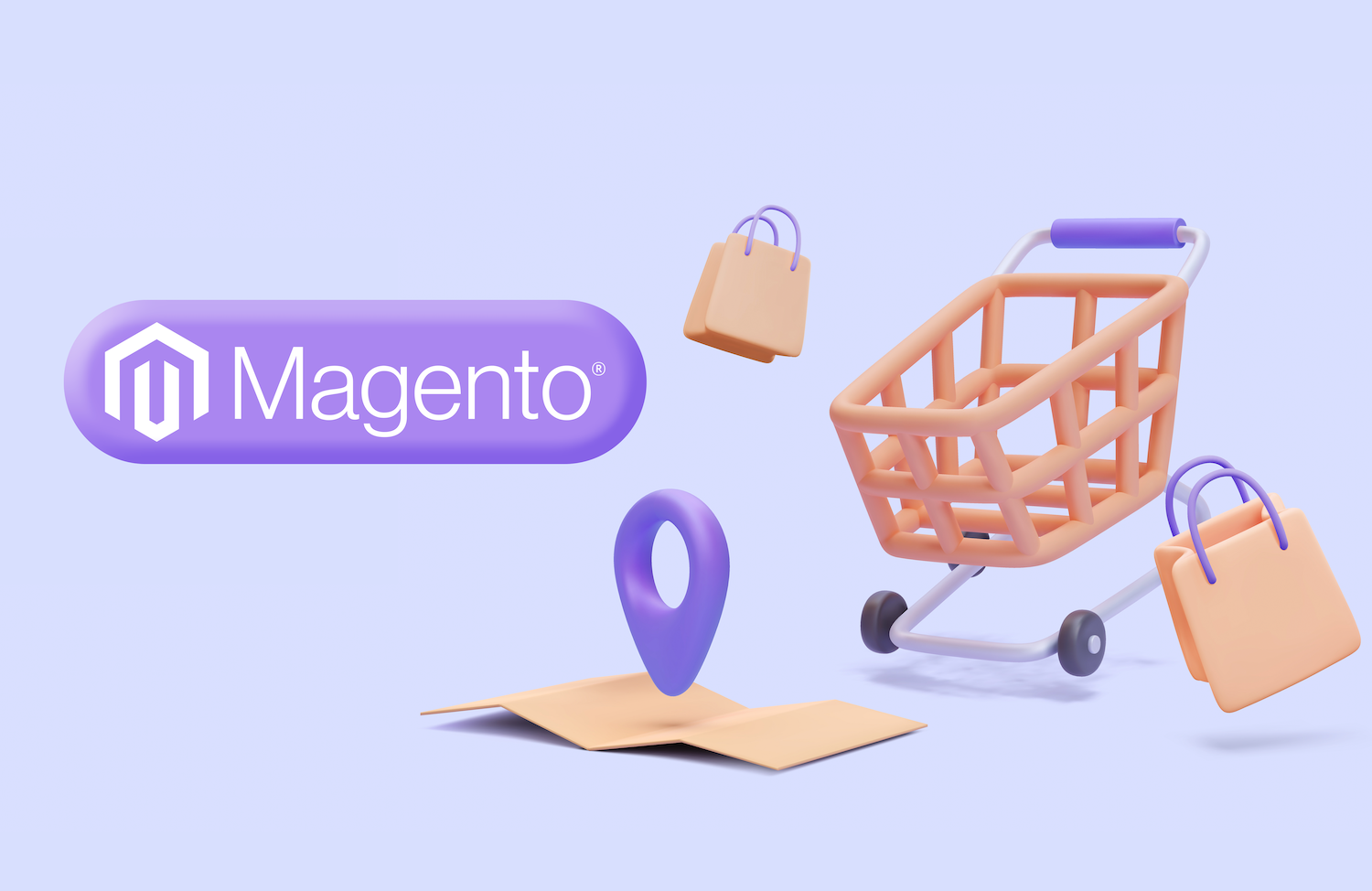The success of any digital commerce operation begins with something as basic as the choice of eCommerce platform on which to develop an online store, as the right tool needs to offer features according to your specific line of business as well as support your brand’s needs even as they evolve with time.
While many brands successfully sell through third-party marketplaces such as Amazon or even self-operated (branded) eCommerce stores using out-of-the-box SaaS solutions like Shopify, when it comes to meeting the challenges that cross-border eCommerce and global expansion entail, Magento (Adobe Commerce) is one of the eCommerce Platform Comparison: Magento, Shopify, & moreFrom entry-level site builders to powerful eCommerce solutions, we ranked the top platforms, as well as their advantages and disadvantages.best Enterprise-level eCommerce solutions given the high degree of customization and scalability that its framework provides.
This is why hundreds of thousands from the top eCommerce websites—including multinational brands such as multinational brands like T-Mobile, Coca-Cola, and Krispy Kreme—opt for custom eCommerce development and are powered by Adobe’s software.
As a custom eCommerce development agency that has built online stores over the years for international customers from a broad range of industries, we often get asked questions such as:
- How do Magento Open Source and Adobe's Enterprise solution compare?
- How can I avoid going over budget on my eCommerce project?
- What are my alternatives to Magento?
To answer this, we’ve put up this straightforward Buyer’s Guide covering the ins and outs of Adobe Commerce in order to help you make the best choice for your business. Here, we will also explore some of the key functionalities that make Magento a no-brainer for particular use cases, the difference between its Open Source and Enterprise versions, as well as examples of successful implementations, and our recommendation on when you should and shouldn’t go for this eCommerce platform.
Already making the move to? Read Magento 2 Migration: How to Prepare your Team as a Project LeadTips and key steps project managers can take to align internal teams, prevent scope creep, and keep a Magento 2 project on time and budget.How to Prepare your Team for a Magento Migration
Magento: Pros and Cons
Magento is one of the leading eCommerce platform solutions in the market. Its many features enable both B2B and B2C businesses to create and manage their online stores effectively and offer highly customized shopping experiences. Based on a PHP core code, and with the option for additional custom module development, its framework is perfect for large enterprises with complex business requirements and brands who want to develop a unique look-and-feel to their eCommerce.
| Pros | Cons |
|---|---|
| ✅ Rich customization options allows for the creation of a unique customer experience (eg. when you need to manage multiple brands/markets, localizing user experience across sites is crucial). | ❌ Steeper learning curve for day-to-day operation. |
| ✅ Multi-store function makes it easy to establish independent websites in multiple countries with unified back end management. | ❌ Richness and flexibility result in high operation complexity, requiring experienced developers. |
| ✅ A vast community of developers and users, with detailed resources and help. | ❌ How to Upgrade to Magento 2 (from Magento 1)Migrating to Magento 2 from Magento 1 may seem daunting. Make sure to follow these key steps and precautions when tackling the move.System Migration & Upgrades may require professional expertise. |
| ✅ Highly-scalable, able to handle large product catalogs and high traffic, suitable for growing operation and expanding into new markets. | ❌ Requires a lot of server resources to run efficiently, which may result in higher hosting costs. |
When assessing the advantages and disadvantages of Magento summarized above, you can already sense that it is a platform aimed at businesses looking for more advanced eCommerce solutions.
Not sure where to start? We can help you assess and implement a winning digital commerce strategy.
On top of these already impressive native capabilities, using Magento means being a part of the largest commerce ecosystem in the world, getting access to a robust global network of Adobe Commerce Certifications: What to look for when choosing a Partner AgencyIf you are outsourcing an eCommerce project on Adobe Commerce (Magento), here is an overview of the credentials a good business and development team should have.Adobe-certified developers and partner agencies, support communities, and a marketplace of almost 5,000 extensions and add-ons.
For brands with higher business needs or seeking B2B-specific enhancements, opting for Adobe's Enterprise Solution (Adobe Commerce) also offers the possibility of integrating with other products from the Adobe Experience Cloud suite, such as Experience Manager, to create unique and engaging online experiences.
Now, let’s dig into the eCommerce development options that Adobe has to offer.
Magento (Open Source) vs Adobe Commerce (Enterprise)

If you have been researching your eCommerce implementation, chances are that you have run into the claim that “Magento is now Adobe Commerce”. While it is true that the platform went through a rebranding in 2021, this has sparked some confusion as to what it exactly entails.
A clearer picture is that there are actually two eCommerce solutions by Adobe—a free-to-use open-source version aimed at smaller businesses and developers called Magento Open Source (formerly Magento 2 Community edition), and a paid version aimed at large firms called Adobe Commerce (formerly Magento 2 Enterprise).
While Magento Open Source and Adobe Commerce share the exact same underlying codebase and hence the same level of flexibility and customization, the latter offers more features in its out-of-the-box state as well as the option to be cloud-hosted as a PaaS (Platform-as-a-Service) solution. Let’s look at the main differences between both platforms:
| Magento Open Source | Adobe Commerce | |
|---|---|---|
| Cost | Free to download and use with no license fees. | Requires licensing from Adobe starting at US $15,000/yr. |
| Marketing | Basic tools such as promotions, coupon codes, and cart price rules, as well as simple product recommendation and cross-selling to increase sales opportunities. | Advanced features like customer segmentation and personalized recommendations, and integrates with Adobe Experience Manager (AEM) & other Cloud products. |
| Analytics | Requires third-party services for reporting and analysis. | Built-in tools provide in-depth reporting and analysis. |
| Additional Modules | Does not have additional features. | Live Search, seller-assisted shopping, B2B and Business Intelligence features, Adobe App Builder, and more. |
| Hosting | Needs an external provider to host the storefront. | On Adobe Commerce Cloud or on-Premise. |
| Support | Basic tools such as promotions, coupon codes, and cart price rules, as well as simple product recommendations and cross-selling to increase sales opportunities. | On Adobe Commerce Cloud or on-premise. |
While one version obviously offers more convenience and functionalities—as paid versions should, both platforms offer excellent performance and there is no clear-cut answer when choosing one over the other, so your decision will mainly boil down to your budget and specific business needs.
For a more detailed list of functions and use cases, check out our Adobe Commerce Services overview page.
Magento (Adobe Commerce) Cost Overview
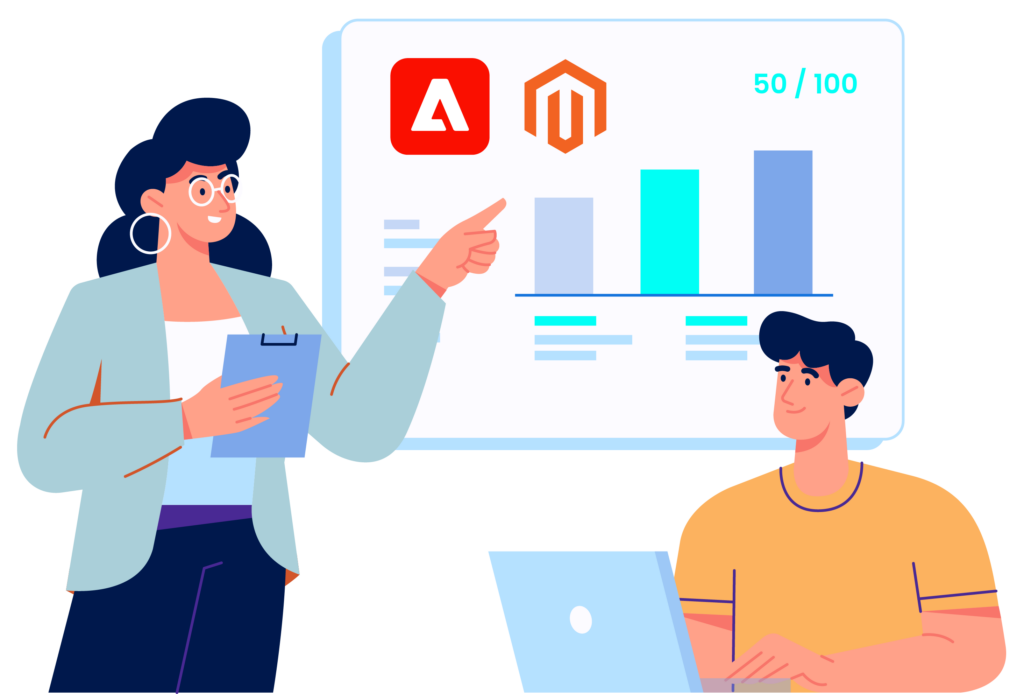
Cost is undoubtedly an element that needs to be carefully considered in any project. As mentioned above, Magento Open Source can be used for free, although these license fees represent only a part of the equation that is the overall eCommerce development. We can roughly divide the costs into the following:
- License Fees
- Development Costs
- Hosting Fees
- Maintenance and Support
Adobe Commerce’s annual license ranges from US $15,000 to over $100,000 depending on the size of the project. In terms of development costs, Adobe Commerce also tends to incur higher costs as it’s correlated with more complex implementations.
For specific assessment of your needs, you can contact TMO for a quotation for your eCommerce development project.
When it comes to hosting costs, Magento Open Source will depend on the particular hosting provider selection, while Adobe's Cloud Hosting will depend on the project's needs in terms of server resources, storage, and bandwidth.
Purely in terms of price, Magento Open Source appears to be a more cost-effective choice that can already meet the needs of complex implementations, including that of centralized management for multi-region stores. For enterprises with B2B requirements or very particular business functionalities to be developed, Adobe Commerce's added capabilities might also be a great choice.
If you are assessing an eCommerce project and fear that you risk going over budget, let’s take a look at some options that exist for controlling development costs.
How to Control Development Costs on your eCommerce Project
Option #1: Can predefined templates or third-party modules effectively reduce costs?
For most customers with no prior experience with Magento, using third-party modules or predefined templates might seem like an effective way to save budget and development time. While true, each external component that you plan on including in your online store is a decision that must be examined very carefully, as there’s the potential for this method to bring very high costs down the line.
Using third-party modules or predefined templates may expose enterprises to compatibility risks, security vulnerability issues, and more, leading to higher maintenance and development costs over time or in the future. We cannot stress enough how important it is to evaluate the quality and suitability of these add-ons.
Especially when large companies have considerable customization requirements, pre-made templates or modules might not be the best way to go. In these cases, at TMO we often insist on customizing all core eCommerce processes, such as user registration, login, and payment processing, to avoid additional issues or risks.
Option #2: Going for lower-cost SaaS alternatives like Shopify

Another feasible option depending on your business needs might be going for a Software-as-a-Service solution, such as Shopify.
Apart from Magento, TMO Group offers eCommerce development services on SaaS platforms like Shopify or WooCommerce.
Let’s take a look at the differences between Magento and Shopify:
| Magento | Shopify | |
|---|---|---|
| Applicable Enterprises | Suitable for large enterprises and stores that require a high-degree of customization. | Simpler, faster onboarding experience for start-ups and small to medium-sized businesses. |
| Cost | Requires greater initial investment. | Relatively low-priced, offering different levels of packages from US $29-299 monthly. |
| Hosting | Full control over the website and its assets, including code, database, etc. You can modify the source code, integrate third-party extensions, and control all aspects of your website, making it ideal for deep customization. | Shopify’s hosting solutions can reduce technology and maintenance costs. |
| Ownership | Full control over the website and its assets, including code, database, etc. You can modify the source code, integrate third-party extensions and control all aspects of your website, making it ideal for deep customization. | Businesses can control the content of the website (products, categories, and design) but the infrastructure (servers, software) is owned and managed by Shopify, and you do not have direct access to the platform’s source code, so customization options will be limited. |
Our recommendation is that for start-ups and small to medium-sized businesses, consider using Shopify as it offers a simpler, lower-cost solution with a decent user experience and support. For larger enterprises, especially in terms of asset ownership, open-source solutions like Magento might be the better investment.
For a full overview of the top eCommerce platforms by tier and use case, check out our eCommerce Platform Comparison: Magento, Shopify, & moreFrom entry-level site builders to powerful eCommerce solutions, we ranked the top platforms, as well as their advantages and disadvantages.2024 eCommerce Platform Comparison including cost, usability, and features.
Option #3: Magento's performance can offer a great benefit-cost ratio
While the initial investment cost of developing a Magento store is relatively high, the overall implementation cost of your project will be determined by the degree of customization, integration and data migration, performance and scalability, regular maintenance and support, and other requirements. Furthermore, a well-optimized online store with functionalities specifically customized to your business needs will prove a better investment over the long run when compared to a less-optimized store built with predefined modules.
Magento gives you more control and ownership of your website, making it ideal for businesses that require deep customization and flexibility. For example, if a brand hopes to highlight its brand style and provide users with a unique experience through a unique UI/UX design , it needs to achieve this through customized development. In terms of business needs, functions such as customized delivery timing and notification mechanisms may be required for cross-border orders. Furthermore, companies can customize development according to their own business needs in terms of customer service processes, product management processes, marketing and promotion processes, data analysis and reporting processes—this is because the company has full ownership of the code and can carry out extensive customization.
See Henry Schein (Singapore/Malaysia)Henry Schein's globally-unified back end, advanced B2B procurement and fully-localized UX/UI for Singapore & Malaysia help easily expand operation within SEA.how Henry Schein transformed it Singapore and Malaysia digital operations with an online store powered by Adobe Commerce.
It is worth noting that cost optimization should not be limited to implementation costs. Management should perhaps focus on the total cost of ownership of the project from the perspective of the company's interests. For example, the ownership and control of an eCommerce system, users and data can also be used as an important asset for the company's long-term development.
Use Cases for Magento
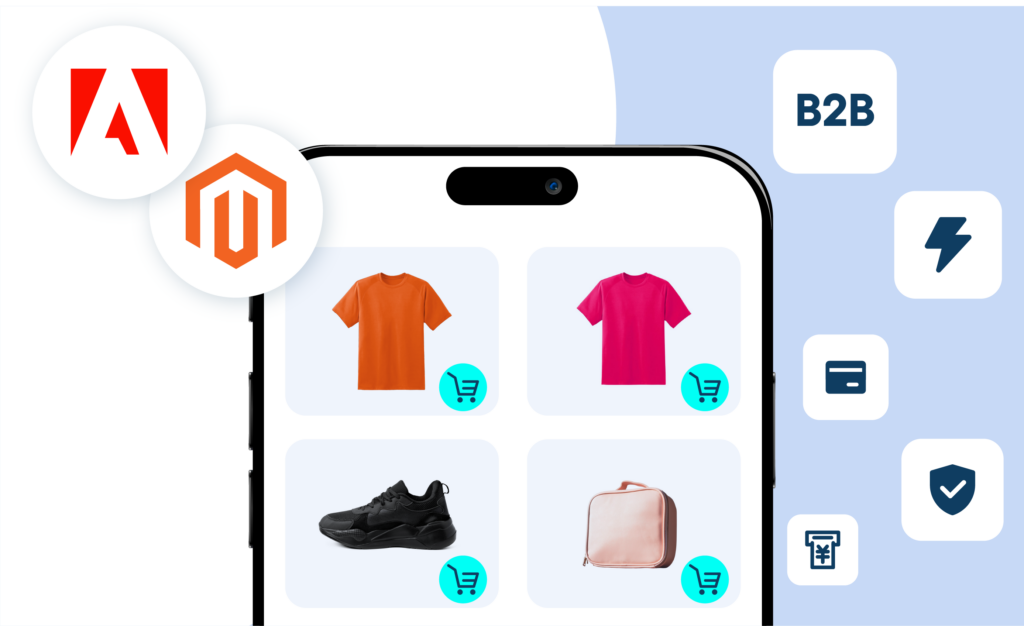
Based on TMO’s years of experience in understanding enterprise needs, we can identify some main use cases that can greatly benefit from Magento's flexibility and functionalities:
1. Cross-Border eCommerce & Global Expansion Key Features
For international cross-border e-commerce platform development, one of the main advantages of Magento is its multi-store functionality, which allows enterprises to run multiple stores from a single system instance or a single management interface.
So how to achieve international expansion/growth with Adobe Commerce (Magento)?
- Setting up an e-commerce structure suitable for international expansion: We need to understand the four levels of the Magento system: global, website, store, and store. Each level offers different flexibility, with most international retailers opting for a combination of configurations to provide a localized experience for their customers.
- Managing international customer experience: When a company needs to manage multiple brands and market players, the experience of international customers when switching between sites is very important! Magento offers flexible customer management options in this regard.
- Product catalog and sales: Build product catalogs according to business needs, and you can set product attributes for different target markets.
- Currencies and Pricing: Pay in multiple currencies, display product prices, and more.
- Other elements that need attention include multiple inventory/warehouses, promotions, multi-language e-commerce systems, search, payments, international tax, shipping and fulfillment, regionalized content and marketing, cross-border data protection, etc.
2. China Localization Key Features
The Chinese eCommerce ecosystem differs a lot from the rest of the world–interactions that are taken for granted in China often are not included in Western eCommerce platforms. To address this, at TMO we have developed a series of extension modules for Magento to add a range of functionalities from top Chinese eCommerce platforms. Some of the features that a good China eCommerce localization should address are:
- Mobile-first Login: Given the low usage rate of email in China, login via phone number is the easiest way to keeping your audience engaged, allowing you to send notifications and register your store's users.
- WeChat Integration: WeChat registration is also a must-have, as it reduces frictions in the user journey and allowed businesses to connect through social media accounts.
- Payment Gateways: Services like Alipay and WeChat Pay are essential to the success of any online store operation in China.
- Localized Checkout: Features like address formatting to fit local writing conventions, ID check, and shipping status check are basics in China's online shopping ecosystem.
Examples of Successful Magento (Adobe Commerce) Implementations

Many multinational companies choose to use Adobe Commerce (formerly Magento 2 Enterprise Edition) to implement their brand eCommerce website development for good reason: It meets the unique needs and usage habits of different business use cases and allows for market localization and fast expansion into other national markets. Among these brands we can find Microsoft, Omega, Dyson, and more.
Take the case of Hewlett Packard (HP), one of the world's leading manufacturers of personal computers and printing equipment, which launched the first Magento-based online store in Thailand and Indonesia in 2013. When their business expanded to the Chinese market, they decided to upgrade to Magento Commerce 2. Since then, HP has delivered more than 600 new features and enhancements across 130 releases, and following its success in Asia Pacific, HP is working on expanding Adobe Commerce to 27 markets around the world.
At TMO we have compiled more market cases and functional use cases that you can take as an example:
- 10 Outstanding B2B Magento / Adobe Commerce SitesWe cover 10 B2B eCommerce websites built on the Adobe Commerce (Magento) framework, from multi-vendor to self-operated platforms.10 Outstanding B2B Magento/Adobe Commerce Sites
- 10 Inspiring Magento2/Adobe Commerce Websites in ChinaTop 10 well-known international brands that have built websites using Magento 2/Adobe Commerce in China.10 Inspiring Magento2/Adobe Commerce Websites in China
- 10 Successful Adobe Commerce / Magento Websites in Southeast Asia10 remarkable brand eCommerce websites, built with Adobe Commerce (Magento 2), all operating in Southeast Asia.10 Successful Adobe Commerce / Magento Websites in Southeast Asia
Final Thoughts & Recommendations
Generally speaking, both Magento and Adobe Commerce are excellent choices for large brands and stores that require a high degree of customization or expand to multi-national markets, given the enterprise-level features both have to offer. Here are some bottom-line suggestions:
- For companies with cross-border needs for their eCommerce operation, Magento Open Source's core eCommerce functions are still a very reliable choice.
- In some cases where there are specific B2B needs and the budget for advanced development, Adobe Commerce Enterprise edition is a top-tier investment over the long run.
- For startups and small to medium-sized businesses, consider Shopify as it offers a simpler, lower-cost solution with good user experience and support. Keep in mind, however, that the customization of user experience may be limited depending on your needs.
The importance of contract provisions cannot be ignored, such as important terms and safeguards, service level agreements, technical support, data security, and other considerations from an Adobe Commerce/Magento implementation. Working with an implementation team that has been officially certified by Adobe, to formulate clear contract terms can help companies reduce risks. As an Adobe-certified solution partner, TMO provides professional Adobe Commerce (Magento) implementation services and has rich localization project experience. If you have eCommerce platform development needs or want to know about other eCommerce development-related services, feel free to contact us to discuss your project!

